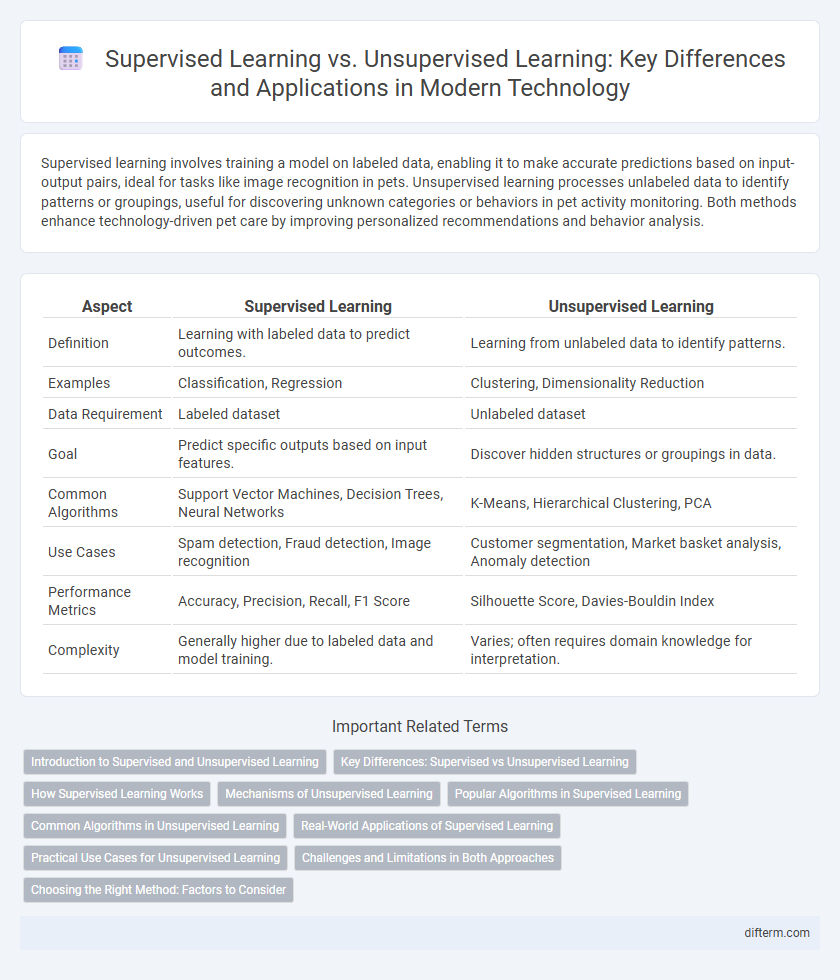Supervised learning involves training a model on labeled data, enabling it to make accurate predictions based on input-output pairs, ideal for tasks like image recognition in pets. Unsupervised learning processes unlabeled data to identify patterns or groupings, useful for discovering unknown categories or behaviors in pet activity monitoring. Both methods enhance technology-driven pet care by improving personalized recommendations and behavior analysis.
Table of Comparison
| Aspect | Supervised Learning | Unsupervised Learning |
|---|---|---|
| Definition | Learning with labeled data to predict outcomes. | Learning from unlabeled data to identify patterns. |
| Examples | Classification, Regression | Clustering, Dimensionality Reduction |
| Data Requirement | Labeled dataset | Unlabeled dataset |
| Goal | Predict specific outputs based on input features. | Discover hidden structures or groupings in data. |
| Common Algorithms | Support Vector Machines, Decision Trees, Neural Networks | K-Means, Hierarchical Clustering, PCA |
| Use Cases | Spam detection, Fraud detection, Image recognition | Customer segmentation, Market basket analysis, Anomaly detection |
| Performance Metrics | Accuracy, Precision, Recall, F1 Score | Silhouette Score, Davies-Bouldin Index |
| Complexity | Generally higher due to labeled data and model training. | Varies; often requires domain knowledge for interpretation. |
Introduction to Supervised and Unsupervised Learning
Supervised learning involves training algorithms on labeled datasets, enabling models to predict outcomes based on input-output pairs with high accuracy. Unsupervised learning processes unlabeled data to identify hidden patterns and intrinsic structures, such as clustering and association. Both techniques are fundamental in machine learning, with supervised learning excelling in classification and regression tasks while unsupervised learning is key for exploratory data analysis.
Key Differences: Supervised vs Unsupervised Learning
Supervised learning relies on labeled datasets to train models, enabling accurate predictions by mapping input data to known outputs. Unsupervised learning processes unlabeled data to identify hidden patterns or intrinsic structures without pre-existing labels. The key difference lies in supervised learning's dependence on labeled data for training, while unsupervised learning excels in discovering data groupings or anomalies independently.
How Supervised Learning Works
Supervised learning operates by training models on labeled datasets where input-output pairs guide the algorithm to learn patterns and make accurate predictions. Algorithms such as linear regression, support vector machines, and neural networks adjust their parameters using loss functions to minimize errors between predicted and actual outputs. This approach enables effective classification and regression tasks in applications like image recognition, speech processing, and fraud detection.
Mechanisms of Unsupervised Learning
Unsupervised learning algorithms identify patterns and structures within unlabelled data by leveraging mechanisms such as clustering, dimensionality reduction, and association rule learning. Techniques like k-means clustering group data points based on feature similarity, while principal component analysis (PCA) reduces data dimensionality to highlight significant variance. These mechanisms enable the discovery of hidden relationships and intrinsic data organization without predefined labels.
Popular Algorithms in Supervised Learning
Popular algorithms in supervised learning include decision trees, support vector machines (SVM), k-nearest neighbors (KNN), and neural networks, each designed to map input data to labeled outputs efficiently. These algorithms excel in tasks such as classification and regression by leveraging labeled training datasets to improve accuracy and predictive power. Their effectiveness in practical applications like image recognition, spam detection, and financial forecasting highlights their importance in the machine learning landscape.
Common Algorithms in Unsupervised Learning
Common algorithms in unsupervised learning include K-means clustering, which partitions data into distinct groups based on feature similarity, and hierarchical clustering, which builds nested clusters by progressively merging or splitting data points. Principal Component Analysis (PCA) is widely used for dimensionality reduction, extracting key features to simplify complex datasets without labeled outcomes. These algorithms enable pattern discovery and data organization in scenarios lacking predefined labels, making them essential for exploratory data analysis.
Real-World Applications of Supervised Learning
Supervised learning drives advancements in image recognition, natural language processing, and fraud detection by utilizing labeled datasets to train models for accurate predictions. In healthcare, it enables disease diagnosis through medical imaging analysis, while in finance, it enhances credit scoring and algorithmic trading. Retail industries employ supervised learning for customer segmentation and personalized recommendation systems, improving sales and user engagement.
Practical Use Cases for Unsupervised Learning
Unsupervised learning enables the discovery of hidden patterns in data without labeled examples, making it ideal for customer segmentation, anomaly detection, and market basket analysis. Techniques like clustering and dimensionality reduction reveal insights in large datasets for targeted marketing, fraud detection, and recommendation systems. This approach enhances decision-making processes in industries with vast unlabeled data, such as healthcare diagnostics and network security.
Challenges and Limitations in Both Approaches
Supervised learning faces challenges in requiring large labeled datasets, which can be expensive and time-consuming to obtain, limiting scalability in complex applications. Unsupervised learning struggles with difficulty in interpreting results and ensuring meaningful pattern extraction due to the lack of predefined labels. Both approaches have limitations in handling high-dimensional data, risk of overfitting, and sensitivity to noise, impacting model accuracy and generalization.
Choosing the Right Method: Factors to Consider
Choosing between supervised and unsupervised learning depends on data availability and labeling costs, where supervised learning requires labeled datasets for accurate model training while unsupervised learning analyzes patterns in unlabeled data. Consider the problem complexity, as supervised learning excels in predictive tasks with clear output variables, whereas unsupervised learning is ideal for exploratory data analysis and clustering. The volume and quality of data, computational resources, and specific application goals significantly influence the selection of the appropriate machine learning method.
Supervised Learning vs Unsupervised Learning Infographic

 difterm.com
difterm.com